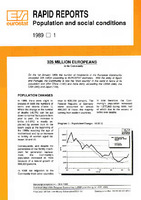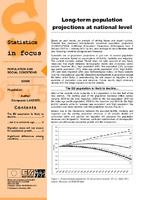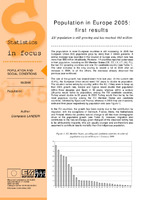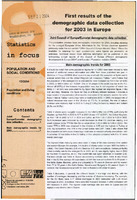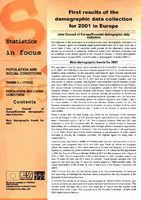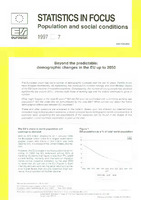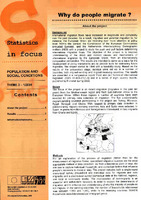Αναζήτηση
Αποτελέσματα 31-40 από 88
RAPID REPORTS Population and social conditions. 325 MILLION EUROPEANS in the Community.
(Statistical Office of the European Communities and Social Statistics, 1989)
On the 1st January 1989, the number of inhabitants in the European Community exceeded 325 million according to EUROSTAT estimates. With the entry of Spain and Portugal, the Community is now the "third country" ...
Statistics in Focus: Population and social conditions. Long-term population projections at national level.
(Statistical Office of the European Communities and Social Statistics, 2006)
Based on past trends, an analysis of driving forces and expert opinion, Eurostat has produced internationally consistent population projections (EUROPOP2004: EUROstat POpulation Projections ...
Statistics in Focus: Population and social conditions. Population in Europe 2005: first results
(Statistical Office of the European Communities and Social Statistics, 2006)
The population in most European countries is still increasing. In 2005 the European Union (EU) population grew by more than 2 million persons. A similar increase was recorded in the Council of Europe ...
Statistics in Focus: Population and social conditions. First results of the demographic data collection for 1997 in Europe.
(Statistical Office of the European Communities and Social Statistics, 1998)
The population of most countries in Europe grew slightly in 1997, though there continued to be some decreases in certain central and eastern European countries. The population of the countries of the European Union grew ...
Statistics in Focus: Population and social conditions. First results of the demographic data collection for 2003 in Europe.
(Statistical Office of the European Communities and Social Statistics, 2004)
This publication provides basic demographic information for 2003, including statistics for the enlarged European Union. Information for the 10 new countries appeared previously under the sub-section "Other Council of ...
Statistics in Focus: Population and social conditions. First results of the demographic data collection for 1999 in Europe.
(Statistical Office of the European Communities and Social Statistics, 2000)
This is the third publication from the joint data collection exercise carried out by the Council of Europe and Eurostat. The country coverage is included in the tables and in the Glossary on the following ...
Statistics in Focus: Population and social conditions. First results of the demographic data collection for 2002 in Europe.
(Statistical Office of the European Communities and Social Statistics, 2003)
The objective of this publication is to provide some basic demographic information for 2002. However, given the timetable (rapid questionnaire sent out in April 2003 with a return date of May), not all countries could ...
Statistics in Focus: Population and social conditions. First results of the demographic data collection for 2001 in Europe.
(Statistical Office of the European Communities and Social Statistics, 2001)
The objective of this publication is to provide some basic demographic information for 2001. However, given the timetable (rapid questionnaire sent out in April 2002 with a return date of May), not all countries could ...
Statistics in Focus: Population and social conditions. Beyond the predictable: demographic changes in the EU up to 2050.
(Statistical Office of the European Communities and Social Statistics, 1997)
The European Union has had a number of demographic surprises over the last 30 years. Fertility levels have dropped dramatically, life expectancy has continued to increase strongly and most Member States of ...
Statistics in Focus: Population and social conditions. Why do people migrate?
(Statistical Office of the European Communities and Social Statistics, 2001)
International migration flows have increased in magnitude and complexity over the past decades. As a result, migration and potential migration to, for instance, the European Union are receiving ...

